
Features
Opinion
Business
Cultivation
Greenman Acres: Sungrown organic flower as nature intended
Grow Opportunity visited Greenman Acres, exploring outdoor living soil cultivation techniques just days before harvest
October 30, 2023 By Haley Nagasaki
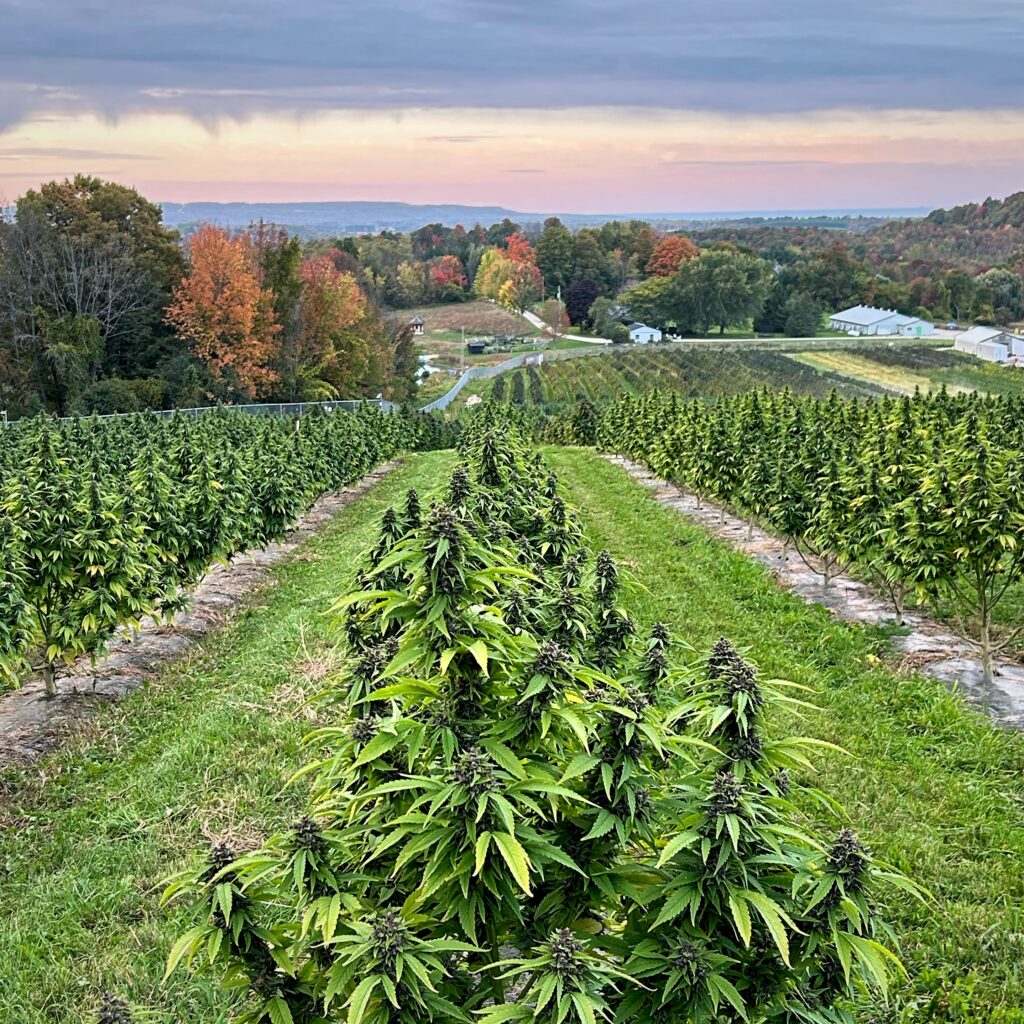 Roadhouse cultivar ready for harvest. Photo: Greenman Acres
Roadhouse cultivar ready for harvest. Photo: Greenman Acres Discover the natural beauty and regenerative practices of Greenman Acres, an outdoor organic dry flower producer in Ontario located in the quiet town of Meaford, near Collingwood, on the southern shores of Georgian Bay.
The peak of the 100-acre farm looks out over 13 acres of actively cultivated land with a vantage of the bay on the horizon. This year, the family-run farm produced seven cultivars, half of which are already in market under several SKUs including Grand Daddy Purple, Mother of Berries, Critical Cure and Scotch Mountain. “It’s the hill it was named after – we’re on Scotch Mountain,” says Cam Hagreen, sales and marketing director of the company. The family owned and operated business is the product of two families united by marriage – Hagreen and Mantrop – beneath the Greenman family moniker.
The stunning landscape and sunny microclimate with its warm lake air suspended in the valley over the summer months create ideal growing conditions for an ecosystem of cannabis plants, beneficial insects and adjacent fallow meadows grown tall for natural wildlife. The tour, which took place mid-September, revealed robust aromatic plants about three weeks away from harvest.
Other cultivars new this year include Roadhouse, a Tahitian Punch and Hitman OG cross, along with Blue Dream not yet in market. “The Blue Dream is an amazing plant,” says company founder Rob Mantrop. “She did so well inside, saying ‘clone me, clone me!’ So, we grew 500 of them.”
Production planning
The mothers grow year-round inside the clean rooms of an indoor facility on site. “It’s our propagation room as well,” says Mantrop. “As we look at making our annual plan in November-December, we look at what we’re going to grow next year and of each quantity, then we start building up our production moms for the purpose of cloning.”
Come April, clones rooted in three-inch pots will be moved into the greenhouse and ideally the first week of June, after the last frost, they are planted outdoors. A job that used to be done manually by hand with shovels has been replaced by a waterwheel planter on the back of a tractor enabling them to plant 1,200 clones over the course of a single morning rather than a 12-person job over a lengthy shift.
Near harvest time, plants come in off the field “for a slow dry followed by a minimum 21-day cure,” says Mantrop. Curing plants have sugar leaves intact after a loose trim coming in off the field. The buds then receive a manicured hand trim once cured.
“So then as we’re fulfilling orders over the year,” says Mantrop, “they’re still curing, and that’s key.”
The organic producer sells dry flower and pre-rolls to the Ontario Cannabis Store made from whole buds, as “we don’t have room to bring shake into the building,” he says. “It takes up too much drying space, so it all gets composted.” The tubes are also fully compostable, made from corn starch, while the flower is coming to market in recyclable glass jars.
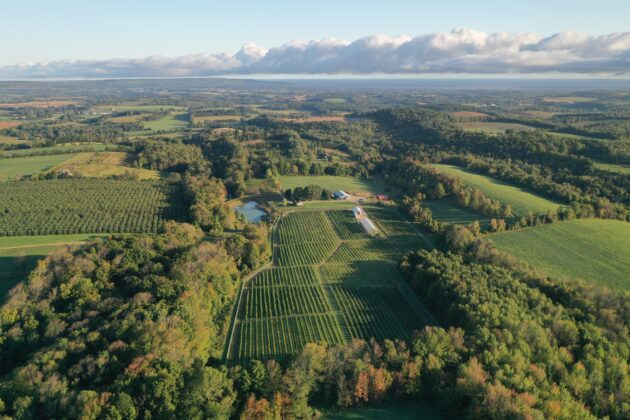
Aerial view of the 100-acre farm. Photo: Greenman Acres
Educational hot spot
What used to be a retired judge’s hobby farm was converted to an organic cannabis farm after Greenman took possession. The farm, located at the end of a dead-end road, is surrounded by other regenerative farmers. “Our neighbours on this side are the Good Family Farm– a 600-acre holistic farm,” says Mantrop.
“We’re joined by the river on both sides. They now bring their cattle over here to other fields and it’s amazing what they’re doing to regenerate the soil. The cattle all free range, rather than bringing tractors, and clean up the understory and the vines.”
It’s an agricultural community, and “we’re curiosity to a lot,” says Mantrop, citing stories of the different neighbours dropping by to poke around their fields.
Formerly, “outdoor growing was guerilla style and you had to be clandestine in a swamp, in a corn field; somewhere unseen” he says. “Once it became legal, we had a blank slate to explore, and now we can put systems in and use full southern exposures.”
The picturesque countryside with its regenerative practices also serves as an excellent educational venue where budtenders and other local retailers are invited to visit the farm each year for interactive sessions.
Visitors are invited to touch and connect with the 20 test strains growing tall in 50-gallon pots in the greenhouse. This year, three events were hosted on site: two budtender-focused events and one that operated as a company retreat for a retail franchise complete with meals and downtime to socialize.
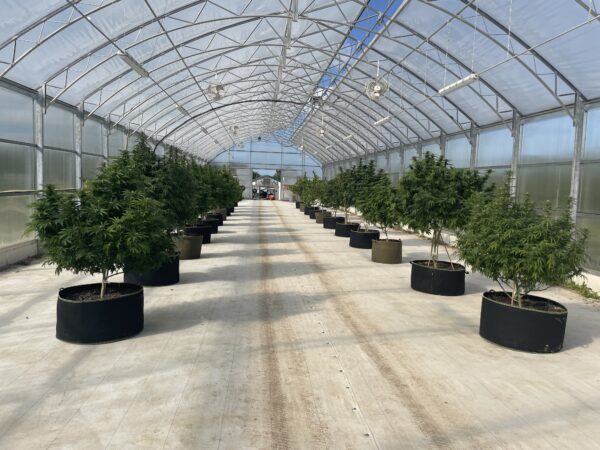
Greenman Acres greenhouse test plants. Photo: Annex Business Media
“Having people come to the farm before harvest,” says Hagreen, “their amazement you get to share with them, and it gives you this energy to keep going.”
“It’s fulfilling,” says Mantrop, overlooking the property.
Recently, the land was also made subject of a two-year study by entomologists with the University of Guelph who completed their thesis on the topic of beneficial insects in outdoor cannabis. “They called and asked if they could join us,” says Hagreen. “Three people, one day a week, all summer long for two years,” says Mantrop. “They scouted our fields, and they taught us how to build a sustainable environment.
The PhD and master’s students studied populations in a survey area and the Greenman team received a weekly report enabling them to watch the evolution of the insect life cycles.
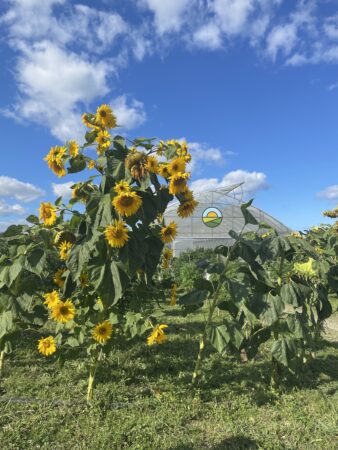
Sunflowers and the Greenman Acres logo. Photo: Annex Business Media
Growing season
Rows of organic cannabis “grow in raised beds and the drip line gets put underneath,” says Hagreen. “New for us this year, these plastic covers on top protect the soil,” bringing worms to the surface and reducing weed pressure and evaporation. This means the team can conserve energy by irrigating and weed whacking less frequently.
The farm traditionally uses local labour, nine people total, and it’s all-hands-on-deck for harvest. “This year we were approached by a staffing agency with landed immigrant workers, so we have 10 of them here who started yesterday,” says Mantrop. “It’s great because we have a work force that all shows up at the same time, and they want to put the hours in, and their level of care is amazing.”
At harvest time, the cultivars have been staged one week after the next to help streamline the process. “Depending on what we’re doing with the plants, some are going to come in for flower. Some will be half for flower, half for freezing, and some will be all freezing,” says Mantrop. “So, we can always have the same amount of people here.”
Walking through the field, Hagreen and Mantrop point out new strains they’re trying, such as a cultivar with a dill pickle terpene that smells like Lays potato chips. Another strain, Roadhouse the brother-in-laws identify, will be the first off the field this year – their own breeding of Tahitian Punch crossed with Hitman OG – a sturdy plant with no trellis required.
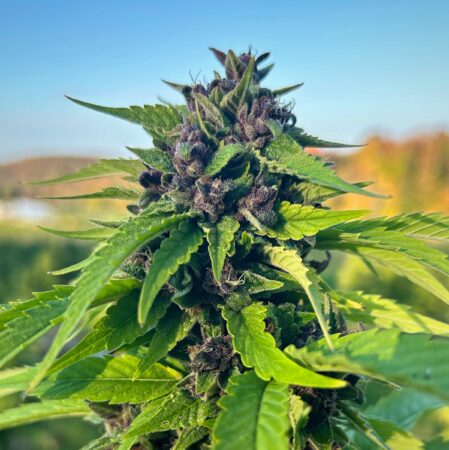
Close up of Roadhouse cultivar. Photo: Greenman Acres
Hagreen also identified a balanced 8:8 strain called CBD Critical Cure that’s selling in market as a 3.5-gram flower. The majority of the plants in the field use trellis to protect against Georgian Bay’s west wind.
“Again, this Blue Dream just earned her way into the field,” says Mantrop. “But it does need support, especially once those buds develop. If there was a heavy rain, those branches would start crashing down.”
Overall, the plants remain fairly low maintenance. “We’re not growing poodles,” he says.
The team scouts throughout the growing season, keeping an eye out for cannabis aphids. By mid-September, “the aphids have done their cycle, they’ve come and gone, and it’s mainly the beetles that take care of them – lace wings and lady bugs,” says Mantrop. In the fall, the team scouts for moth or caterpillar activity, of which there is very little.
“There’s a few things we can use in our arsenal as an organic grower,” he continues.
“The biggest thing is prevention. Aside from feeding through the drip lines, we do foliar spraying treatments, such as regalia, an extract from giant knotweed as an immune booster.”
As the team now concludes their fruitful 2023 growing season, they will spend the winter processing product with time to reflect on the year and consider what improvements can be made moving forward.
“Plant quality and care is what drives our decision making,” says Mantrop. “And then it’s ‘how do we do this and make it more efficient without breaking our backs?’ We talked about the shovels at first – we’re always doing a lot more with less,” he says. “And that’s farming.”
Print this page